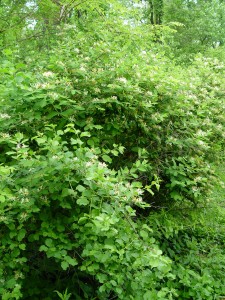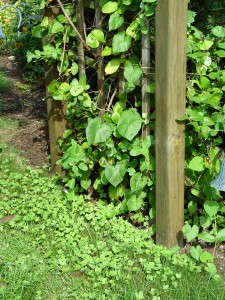Natives vs. Invaders
May 17th, 2011
Gardeners might disagree on whether it’s a good idea to plant non-native plants in the landscape or not, but just about everyone agrees we ought to get rid of invasive species.
That might be a hasty – and wrong – conclusion, according to some intriguing new research from Penn State.
PSU researchers Tomas Carlo and Jason Gleditsch thought they’d test the prevailing notion that invasives are bad for ecosystems because they choke out native species and deprive native wildlife of the food and shelter they depend on.
The pair studied sections of Happy Valley that have been overrun with Japanese honeysuckle – one of our most invasive invaders – and compared bird activity with surrounding urban, agriculture and forested areas.
What they found is that robins, catbirds and other fruit-eating birds actually like honeysuckle fruits and have come to depend on it.
“The abundance of fruit-eating birds in the Happy Valley region is linked to the abundance of honeysuckle,” says Carlo. “Honeysuckle comprises more than half of all the fruits available in the landscape, and it benefits birds by providing them with a source of food in the fall.”
Carlo and Gleditsch then introduced native American nightshade into honeysuckle-infested areas and found that birds took 30 percent more of that than in non-honeysuckle areas.
“The newly introduced plants piggybacked on the success of the honeysuckle,” says Carlo, “which is a common phenomenon because fruit-eating birds usually feed on a variety of fruit – whatever happens to be available to them.”
Now that doesn’t mean the researchers are saying it’s OK to ignore potentially invasive species or that none of them pose any problems.
What their research does suggest is that this issue is a lot more complicated than concluding that native plants are always good and non-natives are always bad.
Once an alien species is introduced, the study suggests, it may be a mistake to try and eradicate it and return areas to their native, pristine state. That’s been the prevailing goal of conservationists, eco-minded land managers and native-leaning gardeners.
Says Carlo: “We wondered, ‘Are we sometimes doing more harm than good when we eradicate plants that, despite being introduced recently, have formed positive relationships with native animals?’… Nature is in a constant state of flux, always shifting and readjusting as new relationships form between species, and not all of these relationships are bad just because they are novel or created by humans. We need to be more careful about shooting first and asking questions later, assuming that introduced species are inherently harmful.”
So what are we to make of all of this when it comes to our home landscapes?
What I try to do is plant as much diversity as possible – natives as well as non-natives – and then stay out of the way as much as possible to let nature sort it out.
I seldom spray anything so as not to interrupt nature’s system of using bugs, weather and disease to determine what plants should grow here and which shouldn’t.
I stay away from plants that get out of control, and that includes species on native-plant “hit lists” (burning bush, non-sterile butterfly bush, barberry, etc.) as well as rampant seeders such as morning glory (a non-native) and hardy ageratum (a native).
And I try to point my disturbed subdivision “soil” back in the right direction by adding compost and using fallen leaves as mulch instead of blowing them out to the curb.
I like most native plants, but I also like plenty of introduced plants. So I guess that puts me somewhere in the case-by-case, moderate middle.
By the way, another “finding-middle-ground” issue is in the trend toward what’s being called “meadowscaping” – a form of gardening I plan to write about in a couple of Patriot-News garden columns next month.
This is a way to replace lawns with native plants but in ways that are acceptable to populated sensitivities.
Catherine Zimmerman wrote a new book on the topic (“Urban and Suburban Meadows: Bringing Meadowscaping to Big and Small Spaces,” Matrix Media Press, $29.95), and I’m going to sit in on a talk she’s doing at this year’s Native Plants in the Landscape conference.
If you’re interested in native plants, that conference is loaded with great info, resources, speakers and plants.
It happens every June at Millersville University, and is open to the public.
This year’s conference takes place June 1-4 and includes programs by fruit expert Lee Reich, former Longwood Gardens plant curator and grass-book author Rick Darke and Cornell urban-tree professor Nina Bassuk.
Check out the full program and more details at www.millersvillenativeplants.org.









